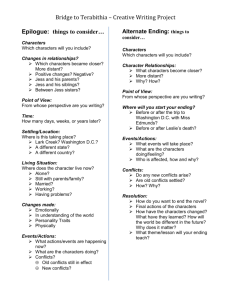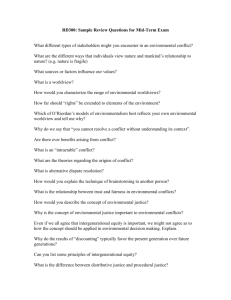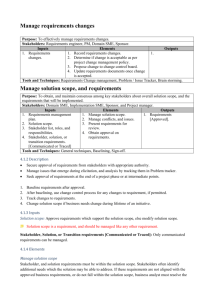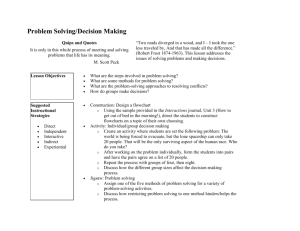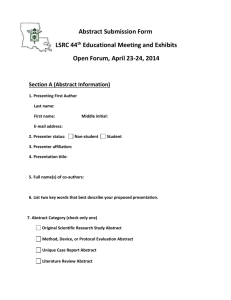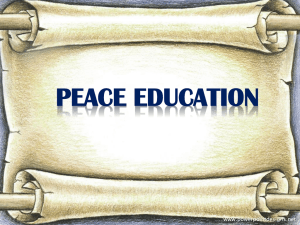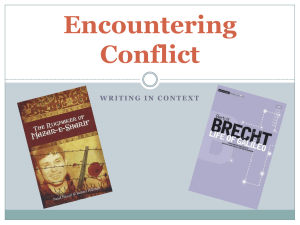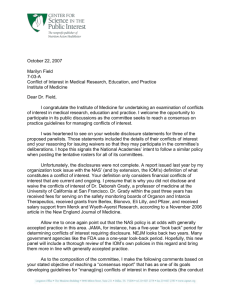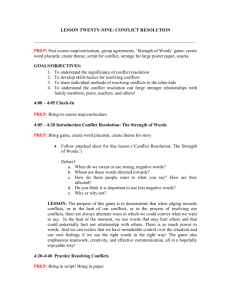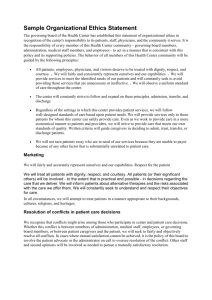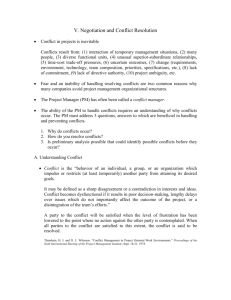Session 11 - Conflict Analysis – Why is it Important
advertisement
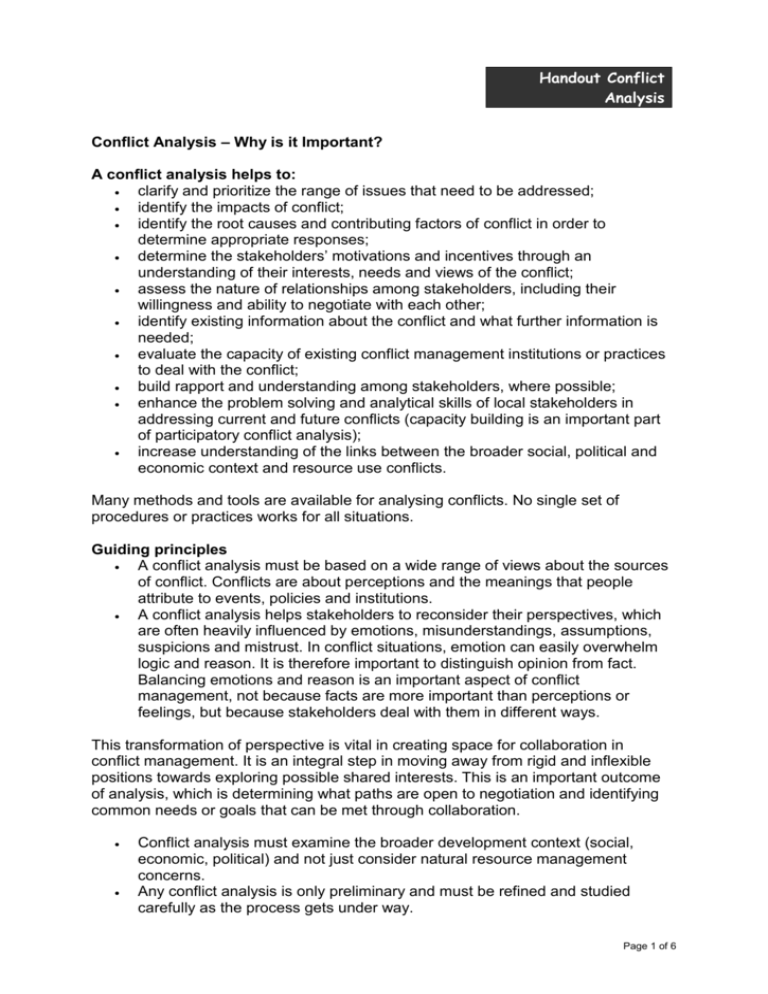
Handout Conflict Analysis Conflict Analysis – Why is it Important? A conflict analysis helps to: clarify and prioritize the range of issues that need to be addressed; identify the impacts of conflict; identify the root causes and contributing factors of conflict in order to determine appropriate responses; determine the stakeholders’ motivations and incentives through an understanding of their interests, needs and views of the conflict; assess the nature of relationships among stakeholders, including their willingness and ability to negotiate with each other; identify existing information about the conflict and what further information is needed; evaluate the capacity of existing conflict management institutions or practices to deal with the conflict; build rapport and understanding among stakeholders, where possible; enhance the problem solving and analytical skills of local stakeholders in addressing current and future conflicts (capacity building is an important part of participatory conflict analysis); increase understanding of the links between the broader social, political and economic context and resource use conflicts. Many methods and tools are available for analysing conflicts. No single set of procedures or practices works for all situations. Guiding principles A conflict analysis must be based on a wide range of views about the sources of conflict. Conflicts are about perceptions and the meanings that people attribute to events, policies and institutions. A conflict analysis helps stakeholders to reconsider their perspectives, which are often heavily influenced by emotions, misunderstandings, assumptions, suspicions and mistrust. In conflict situations, emotion can easily overwhelm logic and reason. It is therefore important to distinguish opinion from fact. Balancing emotions and reason is an important aspect of conflict management, not because facts are more important than perceptions or feelings, but because stakeholders deal with them in different ways. This transformation of perspective is vital in creating space for collaboration in conflict management. It is an integral step in moving away from rigid and inflexible positions towards exploring possible shared interests. This is an important outcome of analysis, which is determining what paths are open to negotiation and identifying common needs or goals that can be met through collaboration. Conflict analysis must examine the broader development context (social, economic, political) and not just consider natural resource management concerns. Any conflict analysis is only preliminary and must be refined and studied carefully as the process gets under way. Page 1 of 6 Conflict analysis is not an end in itself. It is part of the process of defining and learning about the issues (capacity building). For this learning process to happen, conflict analysis must be carried out in a participatory manner. Through exchanges of information it becomes more likely that people will focus on real problems in the negotiation process. However, people are likely to be cautious about revealing some types of information. It is important to know what is worth knowing. The type and amount of information needed from conflict analysis varies from case to case. While it is often assumed that more information is better than less, not all information may be relevant, truthful or useful. In addition, perceived information needs are likely to be constrained by limited time, resources or expertise. When taking such limits into account, it is necessary to define what is meant by “sufficiently” detailed, accurate and reliable information. Data collection or analysis that goes beyond this is not necessary. Key Questions to Assist Conflict Analysis What is the conflict about? A conflict is often more complex than it seems. How do the participants frame the conflict? To what extent are their views alike, and how do they differ? How do others frame the conflict? What seem to be the immediate or proximate factors behind the conflict? Are there deeper livelihood, institutional, political or other structural factors behind the conflict? Trying to manage a conflict as a single, isolated event may be of little use if it is intertwined with wider problems or issues. Who is involved in the conflict? Effective consensus building depends on engaging all the stakeholder groups that are relevant to a conflict. It is therefore important to identify stakeholders accurately. Are there any groups who are not present but who have a direct or indirect role in the conflict, such as administrators, resource users from neighbouring communities or migratory populations (herders, farmers or labourers)? What motivations or incentives exist for the parties to settle their conflict? Trying to get people to settle their conflict through ACM or other means may be difficult if the parties do not feel or perceive a need to manage or resolve it. In addition, there may be economic, political, cultural or other incentives that influence the parties’ willingness to engage in conflict management. Equally important is to find out whether there are people who would benefit from continuation of the conflict, or who would resist attempts to stop conflict (do some people have an interest in perpetuating the conflict?). What conflict management strategies have been tried in the past? It is very important to consider what strategies have already been tried to resolve the conflict. What were the results of these effort? What are the advantages or disadvantages or pursuing the same strategy or strategies for the present conflict? Page 2 of 6 Systematic analysis of an issue, problem, dilemma or conflict helps identification of the main parties or stakeholders, their key interests and the critical conditions (opportunities or barriers) that affect resolution. It also helps the assessment of possible procedures for addressing and resolving issues, and decision-making about how to proceed, including what steps to take first. Below is a ‘Conflict Analysis and Strategy Design’ matrix that allows a conflict management practitioner to assess a conflict. The column headings suggest key areas that need to be analyzed and upon which the practitioner can make an informed decision on how best to proceed in managing the conflict. The ‘speed’ at which this assessment is completed will depend on the complexity of the conflict case, time and resources. However the greater the analysis, the less chance for mistakes and the increased likelihood of being able to genuinely assist the stakeholders in productively managing and resolving the conflict. The matrix is also a useful way to differentiate between very important and less important issues. Page 3 of 6 Conflict Analysis and Design Matrix People/Parties Issues Importance (all the (suggested topics priority) that need to be dealt with) Positions Interests Dynamics Affecting the Conflict Means of Influence and Power Willing to Talk/Settle Possible Possible Settlement Forums, Options Procedures, (for Strategies meeting to Address most of Issues and the Next Steps parties’ identified interests) Page 4 of 6 Source: Adapted from Centre for Dispute Resolution (CDR Associates). Page 5 of 6 Conflict Analysis Tools Below are a number of analysis tools that are extremely useful in allowing for a more in depth analysis of a conflict. The outcomes from these tools can be easily summarized and placed into the ‘Conflict Analysis and Strategy Design’ matrix. The decision of which tool to use will be determined by the nature and complexity of the conflict and time and resources available. Tool Root Cause Analysis Purpose To help stakeholders examine the origins and underlying causes of conflict. Issue Analysis To examine the issues that contribute to conflict and the specific issues that give rise to a specific conflict in more detail, focusing on five categories: 1) problems with information; 2) conflicting interests; 3) difficult relationships; 4) structural inequalities; 5) conflicting values. Stakeholder Identification To identify and assess the dependency and power of and Analysis different stakeholders in a conflict. 4Rs (Rights, Responsibilities, Returns, Relationships) To examine the rights, responsibilities and benefits of different stakeholders in relation to natural resources, as part of improving understanding of a conflict. To examine the relationships among (or within) different stakeholder groups. Force Field Analysis To analyze forces that are either helping or obstructing positive change or productive management of a conflict. It can be useful, as part of drawing up a strategic management strategy or action plan and for examining how feasible a strategic objective is and what areas need to be focused on in any associated action plan. Conflict Time Line To assist stakeholders in examining the history of a conflict and to improve their understanding of the sequence of events that led to the conflict. Mapping Conflict over Resource Use To show geographically where land or resource use conflicts exist or may exist in the future. To determine the primary issues of conflict. (During the training a number of key tools will be used to illustrate both the process and potential outcomes from these tools). Page 6 of 6

